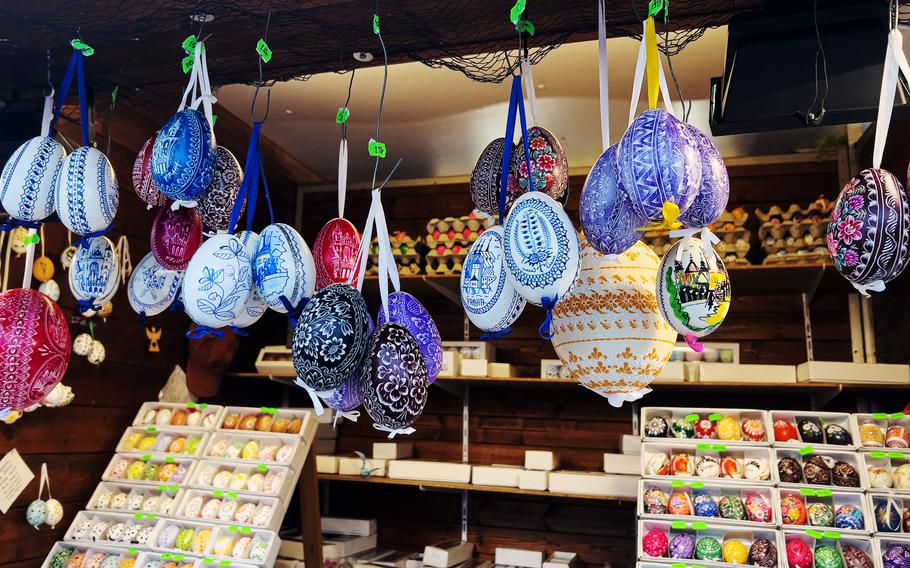
Easter egg markets abound this time of year. (iStock)
We’re now about midway through the period of time Christians observe as Lent, and despite the solemnity of the season, there’s plenty to do to mark this time of year and the upcoming Easter holiday. Here are a few ideas:
Easter egg exhibitions: Painted, perforated, polished or polka-dotted, be blown away by all the ways to beautify an egg at a market where egg artistry stands front and center. German Easter egg markets within easy reach of U.S. military communities include those in Andechs Monastery in Andechs, held March 8-10; Michelstadt in the Odenwald, March 9-10; Bad Arolsen, March 16-17; Fichtenau-Matzenbach, March 23-24; and Bad Wörishofen, March 23-24. On March 24, the fountains of Bad Wörishofen, a charming spa town in the Unterallgäu region, will be lovingly done up in Easter decor. For more dates and details, see ostereiermarkt.de.
Easter markets: In contrast to the above-named egg exhibitions, Germany’s Easter markets are more of a time for perusing spring handicrafts and décor in general. Cities with markets of this type include Nuremberg (March 15-28 and March 30-April 1) and Wiesbaden (March 15-17; includes open shops on the Sunday). Kaiserslautern’s annual spring event, Lautern Blüt Auf, takes place in its downtown area March 16-17 and also includes open shops on the Sunday.
Middle Ages Easter markets: For a market combining Easter with medieval flair, consider checking out that held at Ronneburg Castle, northeast of Frankfurt, March 16-17 and March 23-24. Admission is charged, but those authentically costumed from head to toe enjoy substantial discounts. Online: tinyurl.com/4nc2rkzb. Closer to the Wiesbaden community, the historical Easter Fest at Schloss Dornberg takes place March 30-April 1 in the town of Groß-Gerau. Online: prohistory.de/event/?event=105
Mid-Lenten carnivals: Just when it seemed like carnival season was done and dusted for another year, a handful of towns in Belgium pull out a new round of such events. Carnivals held on Laetere Sunday, the fourth Sunday of Lent (March 10 in 2024), include those in Stavelot, Belgium, where the white costumed Blancs Moussis are the stars of the show (laetare-stavelot.be). The town of Andenne celebrates its annual Carnival of the Bears on March 10 with a parade of costumed bears and the throwing of teddy bears from the Town Hall’s balcony. Online: tinyurl.com/2p3n3swc. The carnival of the Chinels in Fosses-la-Ville, also held on March 10, is known for the quality of its costumes. Online: tinyurl.com/2s2nrjx7.
Pretzel Sunday in Luxembourg: Laetere Sunday is known as Bretzelsonndeg, or Pretzel Sunday, throughout the land. These pretzels aren’t the usual salty ones but a sweet version topped with almonds. On the day (March 10 in 2024), men traditionally present the objects of their desire with a pretzel, but during Leap Years, as is 2024, it’s the ladies who present the men with the pastry treat. If the recipient has accepted the advance, he or she is to present the pretzel-giver with a basket of eggs on Easter; an empty basket on the day amounts to being spurned. Online: tinyurl.com/3dv49n9f
Burning of winter and summer day parades: Laetere Sunday (March 10) is celebrated in many communities of the historical Kurpfalz region of southwest Germany as a day to bid farewell to winter. Heidelberg marks the day with its annual Sommertagszug, a parade in which children carry sticks decorated with pretzels, eggs and ribbons, at 3 p.m. In Speyer, a parade begins at 2:30 p.m. and ends with the burning of the effigy of a giant snowman in the garden of its cathedral.
Celebrate Starkbier season in Munich: Insofar as the monks of centuries past weren’t allowed to eat during Lent, they came up with an ingenious way to make sure they kept themselves nourished during this austere period. The invention of Starkbier, sky-high in terms of both calories and alcohol content, is credited to the monks of the Paulaner Monastery, who brewed one of the first batches back in 1629. Almost 400 years later, these heavy-hitters of the beer world retain their mythical appeal, and numerous celebrations are held throughout Munich’s traditional breweries. Excellent places to rub shoulders with real Bavarians include the Paulaner Nockherberg brewery, birthplace of the Starkbier tradition, the Löwenbräukeller or the Augustine Keller. Starkbier season runs through March 24 this year. See tinyurl.com/38cun5c6 for brewery suggestions and reservations.